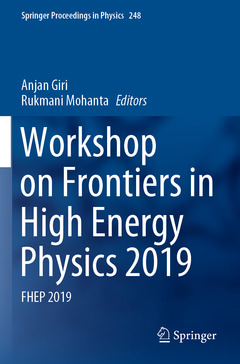Workshop on Frontiers in High Energy Physics 2019, 1st ed. 2020 FHEP 2019 Springer Proceedings in Physics Series, Vol. 248

This book presents the proceedings of The International Workshop on Frontiers in High Energy Physics (FHEP 2019), held in Hyderabad, India. It highlights recent, exciting experimental findings from LHC, KEK, LIGO and several other facilities, and discusses new ideas for the unified treatment of cosmology and particle physics and in the light of new observations, which could pave the way for a better understanding of the universe we live in. As such, the book provides a platform to foster collaboration in order to provide insights into this important field of physics.
Anjan Giri is a Professor of Physics at the Indian Institute of Technology Hyderabad. His work focuses on B Physics, CP violation, neutrino physics and looking for signals of physics beyond the standard models using experimental data. He has published more than 100 highly cited papers in international journals with and is a member of the NOvA and DUNE collaborations at Fermilab, USA and the Belle collaboration at KEK, Japan. He is known for his widely used GGSZ (Giri-Grossman-Soffer-Zupan) method for the determination of CKM phase g.
Rukmani Mohanta is a Professor of Physics at the University of Hyderabad. Her work focuses on phenomenological aspects of flavor physics, neutrino physics, dark matter, and the interplay between the data and theory beyond the standard model scenarios. She has published more than 100 highly cited papers in international journals. She is the recipient of the Elsevier Foundation 2011 OWSD (Organization for Women in Science for the Developing World) award for Physics/Mathematics in the Asia-Pacific region, and is a member of the NOvA and DUNE collaborations at Fermilab, USA.
Presents the proceedings of The International Workshop on Frontiers in High Energy Physics (FHEP 2019), held in Hyderabad, India
Highlights recent, exciting experimental findings from LHC, KEK, LIGO and several other facilities
Discusses future ideas for the unified treatment of cosmology and particle physics
Date de parution : 09-2021
Ouvrage de 471 p.
15.5x23.5 cm
Date de parution : 09-2020
Ouvrage de 471 p.
15.5x23.5 cm



